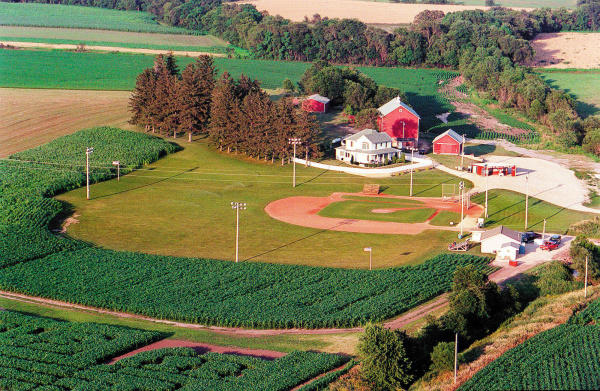
Day 46: Winding Our Way Through Wisconsin
May 4, 2021
Day 44: Bridges, Windmills and Politics in Iowa
May 2, 2021Most recently updated on February 15, 2024
Originally posted on May 3, 2021
Music and baseball.
Those are the main items on the agenda on Day 45 of our journey.
There’s no time to waste, so we head north out of Des Moines on Interstate 35, our traveling companion from Texas and Oklahoma.
After 40 minutes, we zip through the town of Ames, a community of 66,000 people that is home to Iowa State University.
We don’t even slow down as we’ve got another hour of driving to reach our first destination, a historic spot in rock ‘n’ roll history.
We finally pull into the community of Clear Lake, a town of 7,400 people not that far from the Minnesota border that’s a major travel stop on I-35 with restaurants, gas stations and other services.
The area was initially inhabited by the Sioux and Winnebago tribes. It was first mapped in 1832 by Nathan Boone, son of Daniel Boone. The first European settlers arrived in 1851. A sawmill was built in 1855.
Clear Lake is named after its lake, a body of water that is 7 miles by 2 miles with 3,600 acres of surface water. What brings us here today is a building that hugs that shoreline.
The Surf Ballroom first opened in 1934. It was rebuilt in its current location after a fire in 1948. The ballroom has hosted a number of famous performers over the years.
It wouldn’t be that well known except for the musical act that played there on February 2, 1959.

The Surf Ballroom in Clear Lake, Iowa, where Buddy Holly played his last concert. Photo by the Surf Ballroom.
Buddy Holly along with a number of other artists performed in the Surf Ballroom on that evening as part of their Winter Dance Party tour. Admission was $1.25 and the concert didn’t sell out.
The band was supposed to take a bus to their next gig in Moorhead, Minnesota, a drive of more than 5 hours. The 22-year-old Holly, however, wanted to reach that next stop sooner. In addition, the bus’s heater wasn’t functioning properly, making the vehicle quite cold.
So, Holly chartered an airplane. Two other singers, 17-year-old Ritchie Valens and 28-year-old J. P. “The Big Bopper” Richardson joined him. Valens had won a coin toss with band member Tommy Allsup for the third and final seat on the plane. Waylon Jennings, who was a member of the band and would later become a country western star, decided not to take the plane.
The Beechcraft Bonanza aircraft Holly had chartered with an inexperienced 21-year-old pilot at the helm took off in the early morning hours of February 3 from a runway in nearby Mason City.
It didn’t get very far. The plane crashed into a snow-covered farm field six miles from the airport, killing all four people on board.
There is now a memorial at the crash site in the midst of that farmland that was dedicated in 1988. You get there by taking Buddy Holly Place northbound out of Clear Lake. You stop at the Buddy Holly eyeglasses sign along a rural road and get out of your vehicle at the Don McLean American Pie Parking Lot. From there, you ventured on a 10-minute, mosquito-laden walk along a path that the farmer who owns the property has cut.

The memorial in a farm field in Clear Lake, Iowa, where Buddy Holly’s plane crashed. Photo by City-Data.com.
At the memorial, you can find a variety of memorabilia from record albums to eyeglasses to song books.
The Surf Ballroom is still in operation and still hosts musical acts. Memorabilia from the 1959 concert as well as newspaper stories about the crash line the walls. In early February, the ballroom hosts a tribute to the three singers who died on that fateful night.
And, as any rock fame knows, the plane crash was immortalized in Don McLean’s 1971 song “American Pie” with it famous refrain of “the day the music died.”
———————————-
Out of Clear Lake, we take Highway 18 across northern Iowa until we reach Charles City, a town of 7,100 people known for tractors and washing machines as well as a leader of the women’s suffrage movement.
A Winnebago tribal village was once situated here. The first European settlers arrived in 1851 with the community being founded in 1852.
The nearby forests and the Cedar River sparked the early economy. So did the Sioux City Railroad, which arrived in the 1870s.
Today, the city remains a railroad junction with industries that produce food products, chemicals and veterinary pharmaceuticals.
Charles City played a major role in the development of the tractor.
Charles Walter Hart, whose father owned three farms in the region, teamed up with his University of Wisconsin friend Charles H. Parr to form the Hart-Parr Gasoline Engine Company in Charles City in 1897.
In 1901, the business partners coined the word “tractor” by combining the words “traction” and either “power” or “motor.” They built their first tractor that year. By 1903, their company had produced 15 tractors.
Their 14,000-pound Hart Parr #3 is the oldest surviving internal combustion engine tractor in the United States. It’s on display at the Smithsonian Natural History of America Museum in Washington, D.C.
In 1929, the Hart-Parr company was one of four firms that merged to form the Oliver Farm Equipment Company. Eventually, that became the White Farm Equipment Company, which at its peak in the 1970s had a 23-acre complex here with 3,000 workers.

The tractor was invented in Charles City, Iowa. Photo by the City of Charles City.
The plant closed in 1993 and the site remains vacant because in the 1990s it was identified as a Superfund site due to the sands, dust and other industrial waste that was disposed of on the property. The clean-up was completed in 1995 and the site is now monitored by federal agency officials.
Tractors weren’t the only ground-breaking product that Harr and Parr worked on. They also built some of the country’s first washing machines, using electric and gasoline engines. The company had two models, one with three legs and the other with four legs. The Floyd County Historical Museum has preserved many of the Hart Parr items from the company’s history.
On a farm just south of Charles City is the former home of Carrie Lane Chapman Catt. Catt was influential in the women’s suffrage movement and the passage of the 19th amendment that gave women the right to vote. Catt also co-founded the League of Women Voters in 1920.
There is a Carrie Lane Chapman Catt Girlhood Home and Museum on the farm. Catt’s father built the home and the family moved to it from Ripon, Wisconsin, when Catt was 7 years old. The National 19th Amendment Society took over operations of the eight-room house in 1991.
The other well-known resident born here was Robert James Waller, the author of “The Bridges of Madison County” who we discussed we traveled through Winterset on Day 44 yesterday.
They Built It and People Came
We’ve got almost two hours of Iowa countryside ahead of us, so we take Highway 281 south out of Charles City for nearly an hour until we hit Highway 20 at Waterloo, Iowa.
We need to take a moment to discuss this particular highway.
U.S. Route 20, as it’s officially known, is actually the longest road in the United States.
The highway stretches 3,365 miles through 12 states from Boston, Massachusetts, to Newport, Oregon. Along the way it takes you from the Atlantic Coast through Yellowstone National Park to Sioux City in Iowa to Gary, Indiana, to Cleveland, Ohio, to the Baseball Hall of Fame in Cooperstown, New York, to the Atlantic Coast.
The road was designated as a highway in 1926. It avoided the fate of many of the old roadways that were paved over in the 1950s and 1960s to make room for the new interstates.

U.S. Route 20 is the longest roadway in the United States. Photo by the Historic U.S. Route 20 Association.
The Historic U.S. Route 20 Association celebrated the country’s longest road in spring 2021.
Bryan Farr, the president and founder of the Route 20 association, told 60 Days USA he decided to form his organization after driving the entire length of the highway in 2010 for a photography book he was putting together. It was a trip he thought would be a one-time event.
However, Farr fell in love with the highway and decided to make it a full-time occupation. He had driven the cross-country route two other times, including a June 2020 trip in which Farr slept in his car at campgrounds to stay safe during the COVID-19 pandemic.
On April 24, 2021, Farr launched a 30-day adventure, driving the entire length of the highway for a fourth time. He made the trek with Alex Simon, the founder of Zero to Epic, a group that promotes electric scooters. Simon drove the route on an electric scooter while Farr served as his support vehicle.
The pair started in Boston and arrived on the Oregon coast on May 21.
Farr said the trip and his organization was designed to raise awareness of the country’s longest road as well as the communities that still exist along Route 20.
“What we’re trying to do is get people to slow down a little and see the country,” said Farr.
————————-
We take Farr’s advice and head east on Highway 20 for an hour and pull into Dyersville, a town of 4,600 people that is a baseball lover’s dream.
The first European settlers here were 10 families with 42 members who had left Bavaria in 1845 and traveled up the Mississippi River from St. Louis and found the fertile soil of the region. In 1847, James Dyer and his family and friends arrived after traveling from England. They built the town around the Bavarian farmers.
Immigrants from England and Bavaria soon followed. In 1888, farmers and merchants mortgaged their properties to build St. Francis Xavier Church. The 1,000-person congregation was elevated to St. Francisco Basilica in 1956 by Pope Pius XII.
The economy today is still centered on agriculture. Grain crops, livestock and farm equipment manufacturing are among the top industries.
However, it is one corn field in particular that has put Dyersville on the map.
That field was the setting for the 1989 movie “Field of Dreams” starring Kevin Costner.

You can play a little baseball at the “Field of Dreams” complex in Dyersville, Iowa. Photo by Consequence of Sound.
The baseball field used in the film was built on two farms just northeast of Dyersville. After the filming, the two farm families ran separate tourist operations with souvenir stands. In 2007, the Lansing family bought their neighbors’ property and made it a solo enterprise.
In 2012, the organization Go The Distance purchased the field. They have held special events here, including some with Costner. The organization provides 30-minute tours and rents the home and field to tourists.
There are also “ghost teams” that have entertained crowds on Sundays in a facility that held 6,000 fans. In a typical year, 100,000 people visit the facility. The field operators conduct tours and rent facilities.
On August 12, 2021, the New York Yankees and the Chicago White Sox played in a new stadium for 8,000 spectators that was built next to the original field. It was the first regular season Major League Baseball game played in Iowa. The players as well as other special guests walked through a corn field just outside the outfield walls before the game began. The White Sox won 9-8 on a two-run homer into the corn fields in the bottom of the 9th inning. In summer 2022, the Chicago Cubs and Cincinnati Reds faced off on the field with the Cubs winning, 4-2.
In late September 2021, Frank Thomas, the Hall of Fame Chicago White Sox baseball player, announced he had formed the group This is Heaven LLC and purchased a controlling interest in Go The Distance. Thomas will serve as chief executive officer of the new operation.
The complex is now undergoing an $80 million expansion that is expected to completed in 2025. The revamp will add 100 acres to the 190-acre site as well as nine new baseball fields, dormitories for youth sports teams and a hotel. A Major League baseball game wasn’t scheduled for Dyersville for summer 2023 or summer 2024 and Major League Baseball officials haven’t committed yet to games at the Field of Dreams site beyond that.
In another part of town, the National Farm Toy Museum brings in visitors interested in another type of memorabilia. The museum is filled with displays of toys that resemble farm equipment.
Many of the artifacts are from the days when the Ertl Company was headquartered in Dyersville. The company manufactured die-cast farm equipment toys. The firm was founded in 1945 by Fred Ertl Sr., who made toy tractors using his basement furnace. In 1947, he received permission from John Deere to make toys of their products. The operation moved from Dubuque to Dyersville in 1959. In 1980, it was producing 1 million toys per year. They opened a factory in Mexico in 1983. The company has been sold several times and is now owned by RC2.
Taking Our Shot in Dubuque
It’s a half-hour jaunt on Highway 20 to reach our final destination of Dubuque.
This community of 58,000 people sits on the western banks of the Mississippi River where the Wisconsin, Illinois and Iowa borders meet.
The region is called the Tri-State area and Dubuque has been referred to as the “Masterpiece on the Mississippi.” It’s also one of the places in Iowa with hills, sitting at an elevation of almost 890 feet.
The town was settled by Quebec immigrant Julian Dubuque in 1785, making it Iowa’s oldest city. The original settlers worked with the Mesquakie tribe to mine lead. After all the ore was taken out of the ground, the timber industry took over. Eventually, mills, breweries and boat building enterprises were established. The Diamond Jo Line steamboats set up shop in 1874.

The Fenelon Place Elevator in Dubuque, Iowa. Photo by Atlas Obscura.
The local economy struggled in the 1980s. Since then, the riverfront has been developed and the economy has diversified with education and publishing. The city has five institutes of higher learning. In addition, in July 2021 the Simmons Pet Food company began operations at its new 275,000-square-foot facility.
One place you may want to visit when you come here is the National Mississippi River Museum & Aquarium. The mission of the facility is to educate the public about the “life, history and culture of our region and rivers.” Its exhibits include aviaries, backwater marsh life and a greenhouse.
Dubuque is also home to the Shot Tower, the 120-foot-high structure that was built in 1856 to produce lead shot for the military. The 7-story tower was made of stone with 3 stories of soft red brick. It produced shot by dropping molten lead goblets from a grate at the top. The goblets formed the lead shots as they fell into a basin of water at the bottom. At its peak, the tower produced 8 tons of lead shot per day.
After the Civil War, the facility was used as a fire tower. It was abandoned in 1911. It’s now on the National Register of Historic Places and is one of the few remaining shot towers in the world.
Not too far away is the Fenelon Place Elevator. The facility is reportedly the shortest and steepest railroad in the world. It takes people from Fourth Street to Fenelon Place. It’s 296 feet in length and 189 feet above the street below. It has a great view of the Mississippi as well as all three states.
It was built in 1882 by J.K. Graves, the former mayor who lived at the top of the hill and worked at the bottom. It took him an hour to descend around the bluff, so he built the elevator car to transport himself to work. Quite a commute.
Near the short, steep railroad is the Shot Tower Inn, where you can order grinder pork sandwiches among other items.
Seems like a good place to camp for tonight.
Tomorrow, we cross the Mississippi for the third time on this journey and head into Wisconsin.


